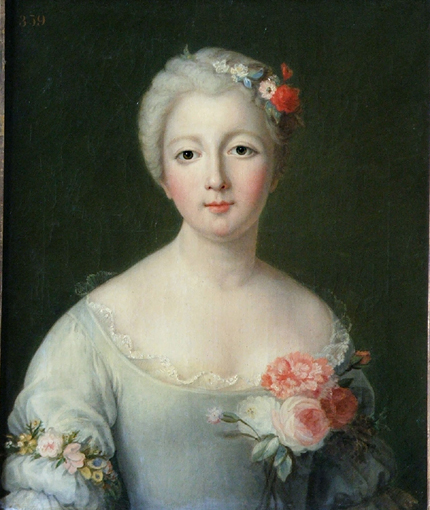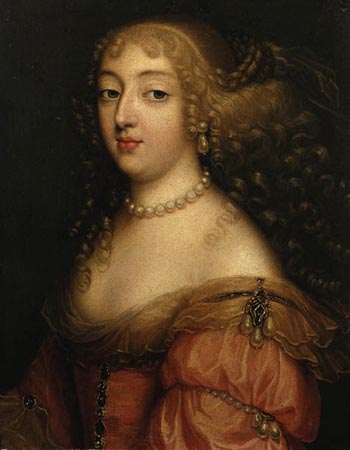Childbirth is a dangerous experience - even more so in an age where knowledge of bacteria was yet more than a century away. Unfortunately, this lack of knowledge resulted in the deaths of thousands of women, of which the ladies of the court were certainly not exempt. Generally speaking, childbed fever (as it was termed) was caused by a streptococcal infection leading to sepsis - unfortunately, this was typically transferred to the birthing woman's nether regions by the hands of those attending her. The numbers vary according to the source; some claim that 40 of 1000 women died during the childbirth itself whereas another source points to 1 in 20. The latter number also accounts for women dying after the birth itself - i.e. from complications - which makes it far more plausible.
At court, the highest-ranking woman who succumbed to death in childbed was the dauphine Marie Thérèse Raphaëlle. She had been married to Louis-Ferdinand for just about a year when she gave birth to their only child on 19 July 1746. Sadly, she appear to have been infected during this period and sepsis soon set in; the dauphine died on 22 July at the age of 20 years old.
The pressure to "produce" an heir for the various aristocratic families often led to such deaths as being quickly forgotten. If the child survived - and was male, mind you - it would still be necessary to produce a spare to the valuable heir. Thus, the late mother was quickly replaced by a new woman. The women involved were often quite young as they were married in their mid-teens and quickly set about establishing the next generation.
Anne Marie Louise de La Tour d'Auvergne, Princesse de Soubise, had been married off at the age of 12. She conceived her first child, a daughter, at the age of 15 before falling pregnant again at 17. The second delivery went wrong, however, when she fell seriously ill after having birthed her son in September 1739. She died shortly afterwards - her husband went on to remarry twice. In a disturbing twist of fate, her successor would suffer the same fate. The widower, Charles de Rohan, remarried a year and a half after the death of Anne Marie Louise to Anne Thérèse of Savoy. Anne Thérèse was 27 years old - in other words a decade older than Anne Marie Louise - when she went into labour with her first child. Little is known of what actually happened except that the Princesse de Soubise died after having giving birth. One can only wonder whether it were the same people attending the two consecutive princesses...
Auguste of Baden-Baden, Duchesse d'Orléans, had given birth three days earlier when she died on 8 August 1726. The 21-year old had been brought to France from Bavaria to marry the Duc d'Orléans just two years earlier. The widower remained unmarried until his own death sixteen years later.
The pregnancy of Gabrielle Émilie du Châtelet, Marquise du Châtelet, was neither planned nor particularly welcome. She had been estranged from her husband for quite a while which allowed them both to indulge in their separate affairs. The extremely intelligent marquise had a steady relationship with Voltaire before becoming entangled with the poet Saint-Lambert. She fell pregnant by him at the age of 42 which in itself caused quite a scandal. There is some suggestion that Gabrielle Émilie had misgivings about her pregnancy; she confided to her friends that she did not think she would survive the birth.
Such misapprehension would be common enough even for a woman who had given birth thrice before. When she went into labour on 4 September 1749, her fears appeared to be well-founded, but not due to gynecological issues. The marquise died of a pulmonary embolism six days after the delivery.
 |
| Marquise du Châtelet |
The daughter of the Duc de Bouillon, Armande de La Tour d'Auvergne, was married at the age of 15 to the Prince d'Epinoy. Rather quickly the young princess conceived their first child; she went into labour in early April 1717. However, something went wrong, although it is unclear exactly what happened. The result was devastating with both the 19-year old mother and the child dying.
The premature death of the Princesse de Conti, born Louise Diane d'Orléans, was the result of a premature delivery. She was five months pregnant when she went into labour at her private estate of Issy. The child appears to have been stillborn but the mother suffered severe complications from her ordeal. For three whole days, she lingered before dying on 26 September 1732, at the age of 20.
 |
| Louise Diane |
Marie Louise Élisabeth d'Orléans, Duchesse de Berri, lived a remarkably scandalous life. Infamous for her numerous affairs, drinking issues and her extreme life style, the Duchesse de Berri fell pregnant which caused yet another scandal. The crux of the issue was that her husband had died five years previously which made it painfully obvious that the child was illegitimate.
The Duchesse de Berri attempted to conceal her state by deceiving clothing and continuing her lifestyle, even continuing participating in theaters and her father's notorious suppers. On 30st March 1719, she went into labour which would turn out to be particularly gruesome. The child, seemingly, would not arrive. For four days, she suffered to the point of a priest being summoned. He, however, refused to give her the last sacrament due to her scandalous lifestyle. Eventually, she gave birth to a girl. Her health was entirely shattered by her ordeal but wanted to continue the illusion of having not been pregnant at all. Thus, she retired to her estate of Meudon where she participated in a ball. However, this exertion was far too much for her weakened body to endure which caused her health to further deteriorate.
Madame herself paid the Duchesse a visit the following month which gives an indication of how poorly she truly was. According to Madame, the Duchesse had severe pain in her feet which caused her doctors to bleed her from the foot. While the pain was somewhat alleviated, her health failed to restore itself. By 21st July 1719, Marie Louise Élisabeth was extremely weak. She died that day; the obligatory autopsy revealed that she was pregnant again.
 |
| Duchesse de Berri |
Originally born in Modena, the Italian Marie Thérèse Félicité d'Este was married to the Duc de Penthièvre in December 1744. She had the good fortune of enjoying a good marriage to her French spouse which resulted in six children. However, when she became pregnant with her seventh child, the Duchesse de Penthièvre had seemingly run out of luck. At this point, Marie was 27 years old and she managed to give birth to a daughter before dying herself. It is unclear whether she died directly after the labour or from puerperal fever.
Her husband was reported to be completely devastated by her loss; for the rest of his life, he was said to tear up when her name was mentioned. Sadly, the daughter, too, did not survive for more than a few hours. For once contemporary sources give an indication of what might have contributed to the tragic incident. Apparently, the many consecutive pregnancies had taken their toll on her body and the labour for each was described as "laborious" which could indicate long labour.
 |
| Duchesse de Penthièvre |
The eldest "Mazarinette", Laura Mancini, had come to France on the invitation of her relative, Cardinal Mazarin. There, she had been married off to the Duc de Mercœur at the age of 14. Giving birth to her first child at 17 and her second at 18, Laura was pregnant again when she turned 20. On 27 January 1657, she gave birth to their third son, Jules César. It is likely that she contracted puerperal fever after the birth which resulted in a period of ill health after the delivery. 14 days later, Laura died.
 |
| Laura Mancini |
The king's mistresses were not excluded from the plight of their fellow women's suffering. Mademoiselle de Fontanges notoriously died at the age of 19 after having given prematurely birth to Louis XIV's child.
Charlotte Rosalie de Choiseul-Beaupré was exiled by Madame de Pompadour for getting too close to Louis XV. She died of childbirth the following year with the child being rumored to be having been the king's. Pauline Félicité de Mailly-Nesle, Marquise de Vintimille, had fallen pregnant by the king. Unlike other women on this list, she died during the childbirth itself from convulsions. The child survived and was raised by her relatives; sadly, her body was mutilated by an angry mob when the guards left their station.
 |
| Pauline-Félicité |

It seems to me that poor Mme de Vintimille had previously eclampsia which turned to full blown eclampsia in labour. It's easily treated now and women are monitored for in during pregnancy now.
ReplyDeleteMarie Louise Élisabeth d'Orléans, Duchesse de Berri, was the First Lady of France when her father became Regent in September 1715. After the death of Louis XIV the young widow became a permanent source of scandal because of her sexual voracity and her repeated pregnancies which she never fully managed to conceal and were a recurring source of inspiration for satirical poets like Arouet (Voltaire). .Berri's last clandestine childbirth is very well known thanks to Saint-Simon who described it at length, turrning it into a rather grotesque comedy... Labor was indeed very violent and lengthy, almost killing the travailing princess and the refusal of the Church to administer her the Sacraments further added moral censorship to her terrible physical sufferings, thus bringing about her demise. She never recovered from the physical ordeal nor from the shame of giving birth while being the target of mockery and dirty jokes by courtiers and servants alike.
ReplyDelete